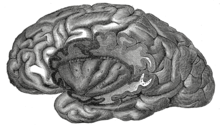Wyspa (anatomia)
Wyspa (łac. insula) – struktura anatomiczna w ludzkim mózgu.
Zaliczana jest do kresomózgowia parzystego (telencephalon laterale), a ściślej do płaszcza. Niekiedy uważana bywa za 5., niewidoczny z zewnątrz płat, często jednak klasyfikowana jest poza tym podziałem. Od otaczających ją płatów oddziela ją bruzda okólna (sulcus circularis insulae). Ma kształt trójściennej piramidy z wierzchołkiem zwróconym ku przodowi i bokowi. Próg wyspy (limen insulae) przerywa bruzdę okólną w okolicy jej wierzchołka. Buduje ją istota szara. Na powierzchni wyspy wyróżniamy zakręty krótkie i zakręt długi oddzielone bruzdą środkową wyspy (sulcus centralis insulae). Dawny podział wyróżniał część przednią (preinsula) i część tylną (postinsula), oddzielone bruzdą środkową. Płaszcz wyspy – kora wyspowa posiada ośrodki wisceromotoryczne i wiscerosensoryczne (pole 13 i 14 według Brodmanna). Płaszcz tworzy torebkę ostatnią oddzielającą wyspę od przedmurza.
Leży ona w dole bocznym mózgu. Jej powierzchnia, w przeciwieństwie do głównych płatów przodomózgowia, nie jest położona na powierzchni, lecz przykryta wieczkiem. Wieczko dzieli się zazwyczaj na trzy części. Wieczko czołowo-ciemieniowe stanowi korowy ośrodek smaku (kora smakowa, pole 35 i 43 według Brodmanna).
Unaczyniona jest przez gałęzie tętnicy środkowej mózgu, które biegną wokół niej[1].
Przypisy
- ↑ Richard L. Drake, A. Wayne Vogl, Adam W.M. Mitchell, Anatomia Gray. Podręcznik dla studentów., wyd. IV, t. 3, ISBN 978-0-323-39304-1.
Bibliografia
- Adam Krechowiecki, Florian Czerwiński: Zarys anatomii człowieka. Szczecin: Wydawnictwo Lekarskie PZWL, 2004. ISBN 83-200-3362-4.
![]() Przeczytaj ostrzeżenie dotyczące informacji medycznych i pokrewnych zamieszczonych w Wikipedii.
Przeczytaj ostrzeżenie dotyczące informacji medycznych i pokrewnych zamieszczonych w Wikipedii.
| ||||||||||||||||||
Media użyte na tej stronie
The Star of Life, medical symbol used on some ambulances.
Star of Life was designed/created by a National Highway Traffic Safety Administration (US Gov) employee and is thus in the public domain.Star of life, blue version. Represents the Rod of Asclepius, with a snake around it, on a 6-branch star shaped as the cross of 3 thick 3:1 rectangles.
Design:
The logo is basically unicolor, most often a slate or medium blue, but this design uses a slightly lighter shade of blue for the outer outline of the cross, and the outlines of the rod and of the snake. The background is transparent (but the star includes a small inner plain white outline). This makes this image usable and visible on any background, including blue. The light shade of color for the outlines makes the form more visible at smaller resolutions, so that the image can easily be used as an icon.
This SVG file was manually created to specify alignments, to use only integers at the core 192x192 size, to get smooth curves on connection points (without any angle), to make a perfect logo centered in a exact square, to use a more precise geometry for the star and to use slate blue color with slightly lighter outlines on the cross, the rod and snake.
Finally, the SVG file is clean and contains no unnecessary XML elements or attributes, CSS styles or transforms that are usually added silently by common SVG editors (like Sodipodi or Inkscape) and that just pollute the final document, so it just needs the core SVG elements for the rendering. This is why its file size is so small.The insula of the left side, exposed by removing the opercula.




